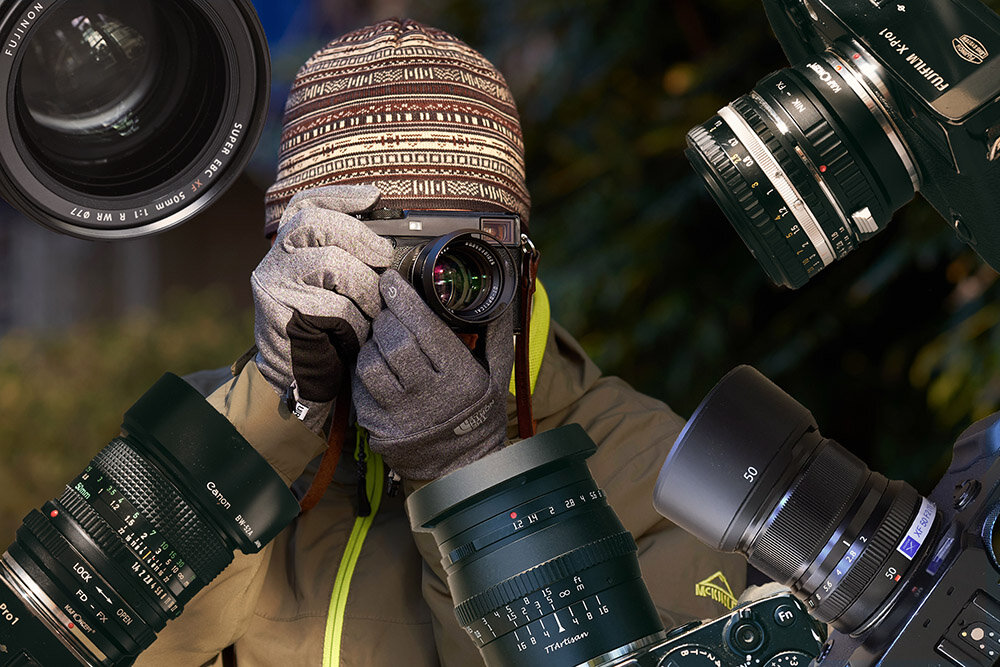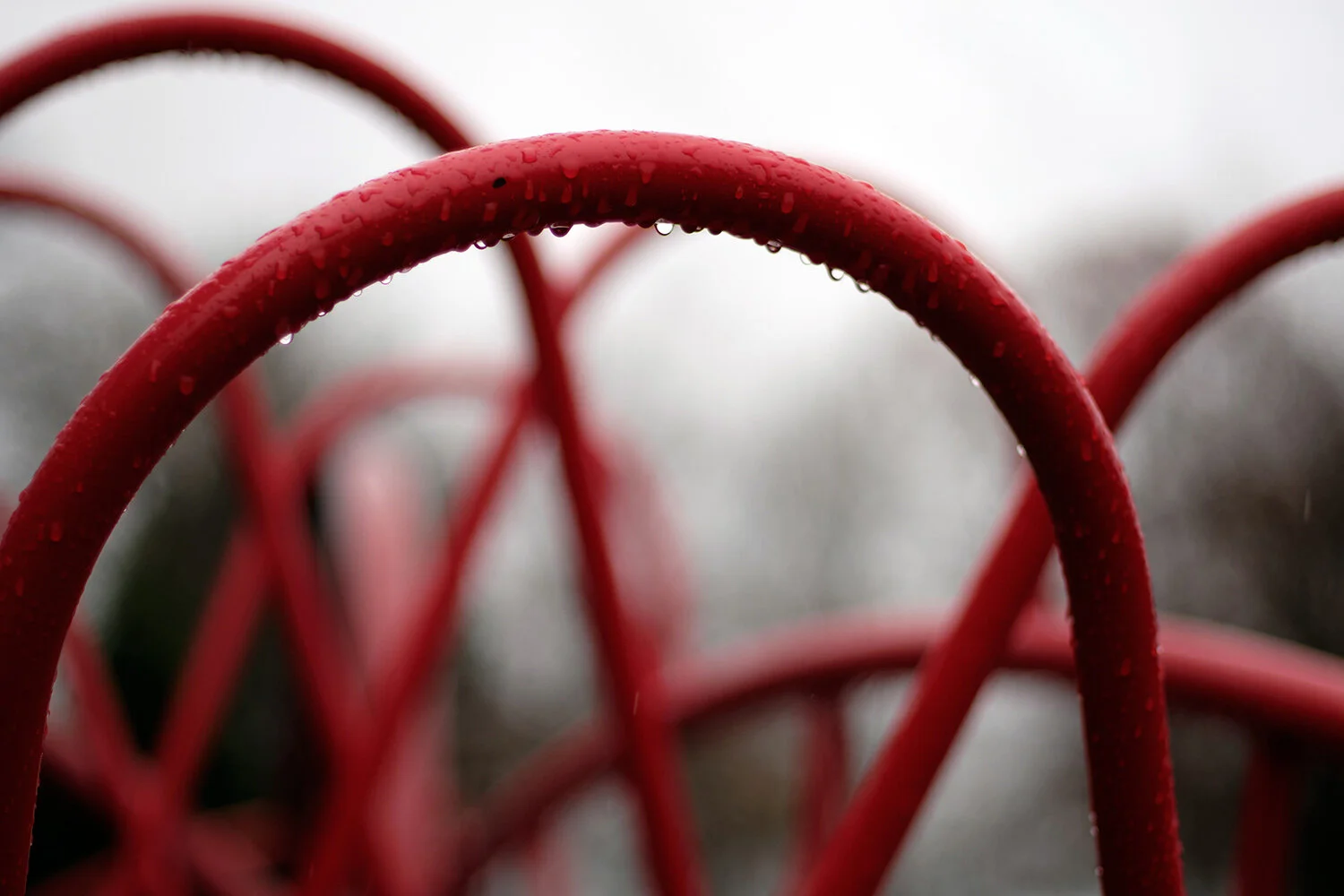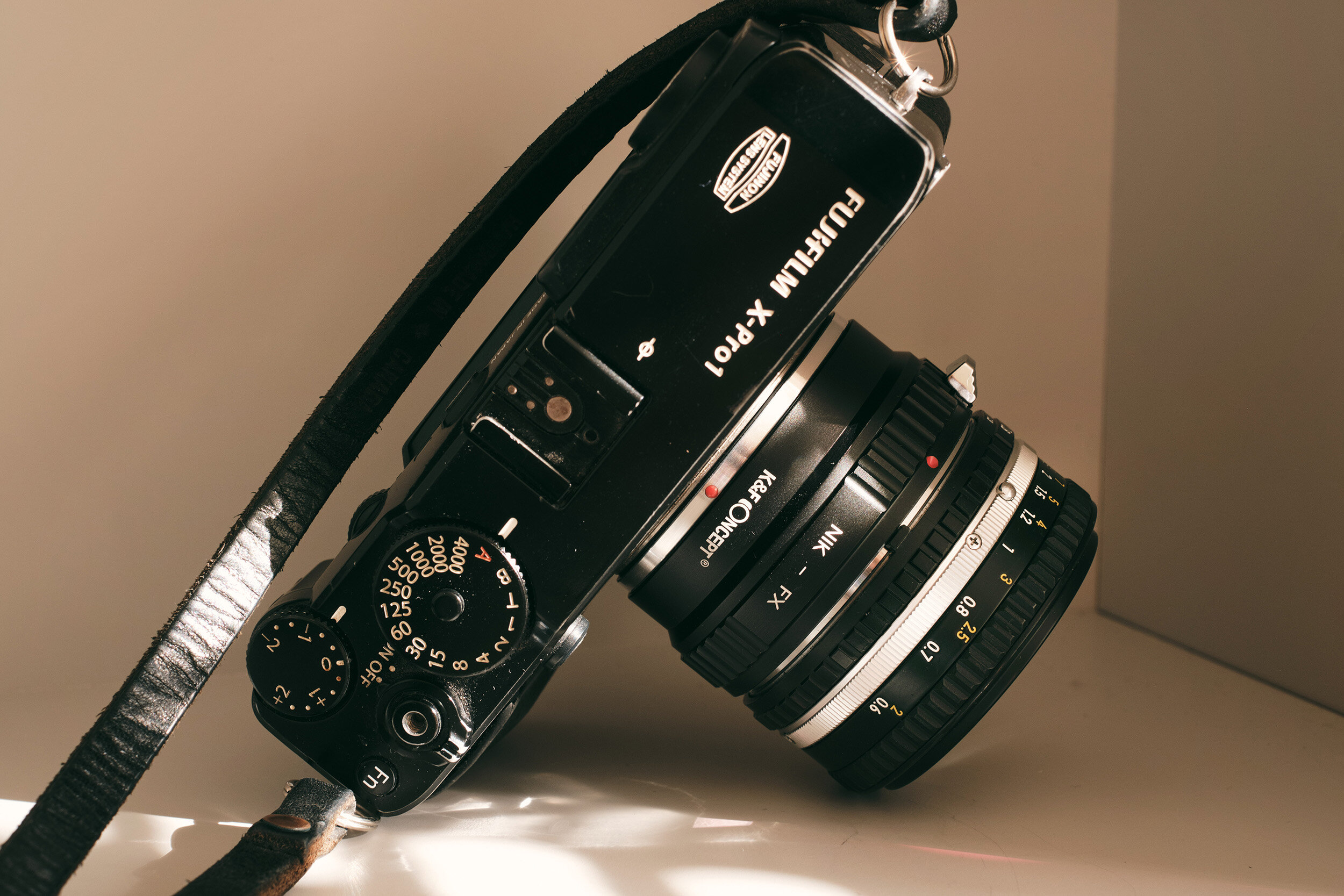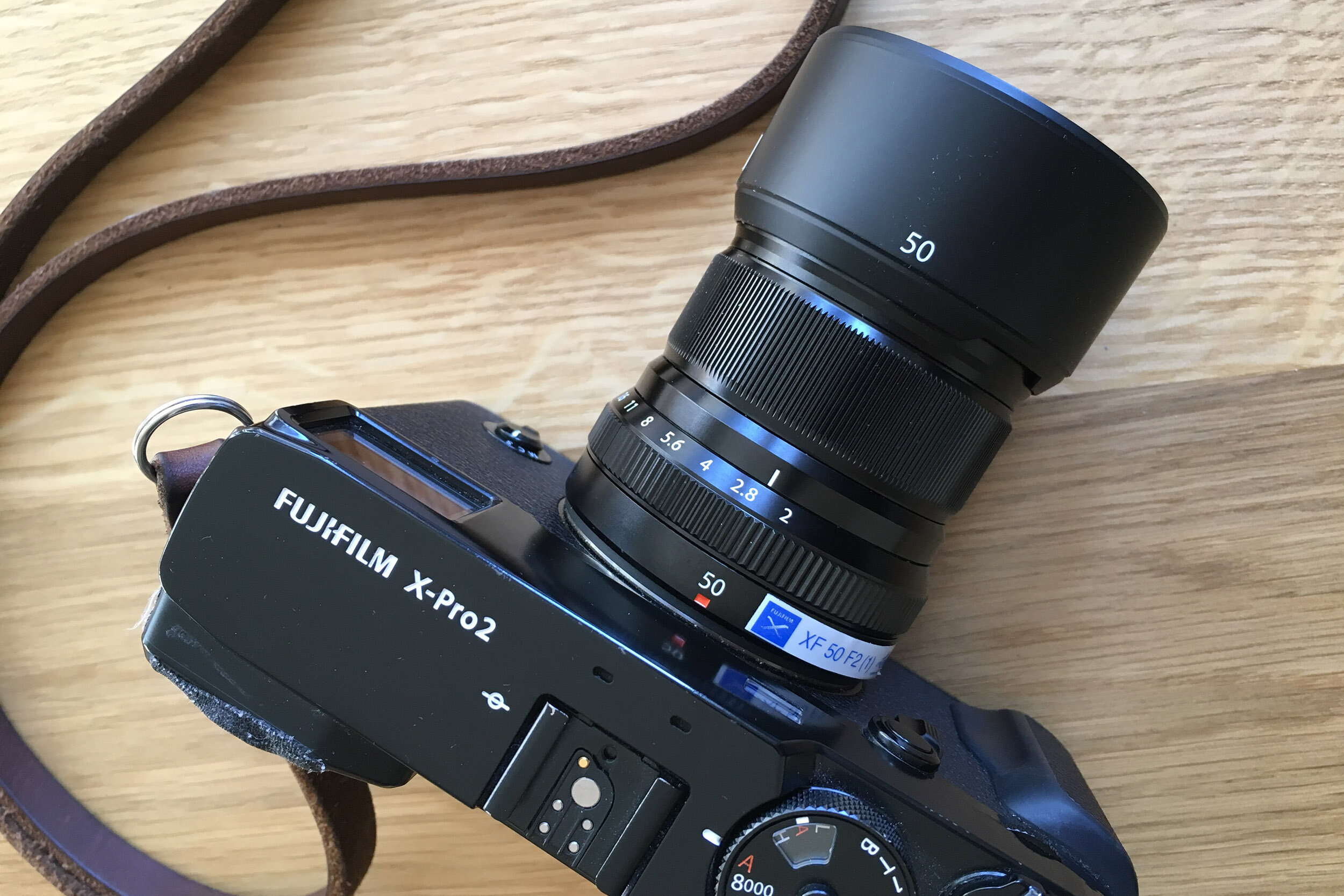50mm Lenses for Fuji X Mount

50mm Lenses for Fujifilm X Mount. Fujifilm XF 50mm f/2 R WR, Fujifilm XF 50mm f/1 R WR, TT Artisan 50mm f/1.2, Nikon 50mm f/1.8 Series E, and Canon FD 50mm f/1.4.
Fujifilm X Mount 50mm Lens Options
50mm is a bit of an odd focal length on the Fujifilm APS-C sensor. At 75mm full-frame equivalent, 50mm on APS-C will yield a very neutral or ‘standard’ look to your photos with very little telephoto compression, if any, and yet the crop factor makes it feel like a short telephoto lens.
For years I shot 85mm lenses on film cameras and full-frame digital SLRs, but in the X-Series, I have pretty much settled on the XF 90mm f/2 R LM WR for my telephoto needs. Realizing the significant gap from my standard XF 35mm to XF 90mm, however, has had me dabbling with a few different 50mm lenses for the Fujifilm X mount.
Testing the TTArtisan 50mm f/1.2 on a Fujifilm X-Pro2, or am I just posing?
Five 50mm Fujifilm X Mount Lenses
This review will include five 50mm options for the Fujifilm X mount. I know there are several more, especially if you count an almost endless number of 50mm lenses that you could choose to adapt to your Fujifilm X Series camera.
The idea for this post was shaped when I bought a couple of old film cameras I used to own in the eighties: the Canon AV-1 with an FD 50mm f/1.4, and Nikon EM with a Nikon 50mm f/1.8 Series E.
Second, I reviewed the two Fujifilm options, the Fujifilm XF 50mm f/2 R WR, and XF 50mm f/1 R WR. Last but not least, I have acquired a TTArtisan 50mm/1.2 for the purpose of seeing how the experience with this lens would compare to adapted lenses.
West End, Vancouver, Fujifilm X-Pro2, XF 50mm f/1 R WR @ f/1
Rating Five 50mm Lenses for Fuji X Mount
In the following, I will be listing the five option from my least favorite to the lens I would pick if I was to clear the table and have just one 50mm Fuji X mount lens for work, play, and travel. So let’s jump in.
Canon FD 50mm f/1.4
I never intended for this lens to be a contender for my Fujifilm X cameras but figured, why not give it try? I picked a K&F Concept adapter as the reviews were decent. While I can see potential in using The FD 50mm f/1.4 lens, I will get straight to the point about an issue I have encountered.
The Canon FD 50mm f/1.4 and K&F Concept adapter mounted on Fujifilm X-Pro1
Using Adapted Lenses
It appears that stopping the lens down does not work with this K&F Concept adapter. Either the adapter is faulty or it’s a Canon FD/K&F Concept thing.
I would appreciate a comment below if you have experience with alternative adapters and Canon FD lenses for the Fujifilm X mount. I have recently added a Canon FD 28mm f/2.8 also and would love to give this one a try also, adapted.
Update: Thank you Alex for the comment. It appears I have used my adapter in the unlocked position. I never even saw this :) Adapter rookie mistake. Please see Alex’s comment below. I can now confirm my adapter works just fine.
Here is a full review of the Canon FD 50mm f/1.4:
Canon 50mm vs. Fuji vs. TT Artisan
Below I have lined up three photos. In order, the first is from the Fujifilm XF 50mm f/1 R WR @ f/1, then Canon FD 50mm f/1.4 @ f/1.4, and finally the TTArtisan 50mm f/1.2 @ f/1.2. The first two are taken at the same time. The TT Artisan is at a later point so not the same framing, unfortunately.
I have never been a fan of using adapters, especially when considering how good the native lenses are. Why bother with an extra piece of gear where precision is jeopardized? You have to focus manually and EXIF info cannot be embedded in your files.
There are, however, a few compelling arguments for trying out adapted lenses. You may already have a few older 35mm lenses kicking around or, like me, you have started dabbling at film photography again. Manual focusing is not as hard as you think using the focus peaking feature.
Below I have another comparison between the Canon 50mm and the XF 50mm f/1 R WR. The first shot will be Fuji XF 50mm followed by the Canon FD 50mm.
The cost of entry is very low. Adapters start around $20.00 and my total outlay for the Canon lens and adapter is around $130.00. This is considerably less than the native Fujifilm options.
I will leave you with four more photos captured over the last few months with the Canon FD 50mm f/1.4 and a Fujifilm X-Pro2. As mentioned above, I see potential with the Canon FD 50mm f/1.4 so perhaps unfair to place it at the bottom of this test. Sharpness does seem to be quite good and I like the colors coming out of this lens.
If you would like to see how the Canon FD 50mm f/1.4 performs on my Canon AV-1, 35mm film SLR, please check my review, Canon AV-1 Review.
Nikon 50mm f/1.8 Series E
Optically the Nikon 50mm f/1.8 Series E is excellent despite being the “budget 50mm” in the Nikon lineup from the late seventies and early eighties.
My sole reason for picking this version was the fact that the Nikon EM we used to have in 1984 came with this lens but I had not really considered adapting it to my Fuji cameras.
The Nikon 50mm f/1.8 Series E adapted to a Fujifilm X-Pro1 with a K&F Concept adapter
K&F Concept Adapter
While I haven’t enjoyed full success with my K&F Concept adapter for Canon FD lenses the adapter I got for my Nikon/Nikkor lenses works very well. Other than the 50mm, I have a Nikkor 60mm f/2.8D macro lens that I use for copying negatives and for product photography.
For macro and stills photography it is less of an issue having to focus manually. Being able to stop down the Nikon 50mm f/1.8 Series E helps in getting more accurate focusing as the higher f-stop number equals more depth of field with a larger margin for error.
Vancouver, Coal Harbour. The Nikon 50mm f/1.8 Series E adapted to my Fujifilm X-Pro2 with a K&F Concept adapter.
The Nikon 50mm f/1.8 Series E, $100.00 including the adapter, renders vibrant Nikon colors as we know it from the eighties, and while perhaps not optically perfect it can add an appealing film look to your images, especially paired with some of Fuji’s film simulations.
I am actually a bit surprised by the image quality in some of the images I have captured with the Nikon lens and at the same time admit I should use it more.
Below are four images from the Nikon 50mm f/1.8E on my X-Pro2.
If you would like to see how the 50mm f/1.8 Series E performs on my Nikon EM, please check my review:
Fujifilm XF 50mm f/1 R WR
The XF 50mm f/1 R WR was a highly anticipated lens as the fastest autofocus lens ever produced and you may wonder why I am placing it here in the middle of the pack.
As a travel photographer portability and manageable weight are key features, and at a cost of $1,499.00 it is the most expensive and the heaviest option in this group of five options for the Fujifilm X mount.
If you are a full-time pro and the bulk of your work is portrait or wedding photography I would revise and probably place the XF 50mm f/1 R WR as the top or next best option depending on your budget.
The XF 50mm f/1 R WR is undeniably impressive. It handles well but is rather bulky and you pay a price for the max aperture of f/1 combined with the autofocus capability.
Below I have four sample images. If you would like to read my in-depth review:
TTArtisan 50mm f/1.2
I felt something was missing from this 50mm shoot-out and held back on the idea of this post until I came across a TTArtisan 50mm f/1.2 review from Jonas Rask. As it happens, this wouldn’t be the first time Jonas has tempted me to buy gear :)
The TT Artisan 50mm f/1.2 is a manual focus lens and while you will have to live without EXIF info the lens comes ready with a Fujifilm X Mount. No adapter is needed.
The TT Artisan 50mm f/1.2 shown here on a Fujifilm X-Pro2 with an optional third-party vented hood
You would think it is merely the incredible bargain price of $98.00 which landed this lens as my second favorite option. But there is more to it than the low cost of entry. The construction feels rock-solid with the smoothest aperture ring you could ever imagine, clickable in half stops.
The manual focusing ring is well-dampened and very smooth. The lens has a Leica feel and looks to it and you honestly scratch your head in disbelief at the price point. How does Leica get away with it?
All this is insignificant if the lens produces horrible images but this is far from the case. Again I am slightly baffled over what I have seen from this lens during the short two weeks I’ve had it.
As with the other lenses, please see the four samples below.
I have now posted a review of the TTArtisan 50mm f/1.2 here:
Fujifilm XF 50mm f/2 R WR
Picking one work, play, and travel 50mm Fujifilm X mount lens which has the most going for it, the XF 50mm f/2 R WR takes the top spot for me. This is based on a combination of price, $449.00, portability, bulk, weight, performance, and the fact that it has autofocus.
The Fujifilm XF 50mm f/2 R WR shown here on a Fujifilm X-Pro2
I know I mentioned that manual focusing is easier than you think but with that said I have been missing shots with all of the above manual focusing lenses.
For paid gigs, portraits, events, or once-in-a-lifetime travel captures autofocus is crucial. I am not saying it cannot be done with a manual focus lens. For decades they managed.
I am however more at ease with an autofocus lens in these situations. With a minimum focusing distance of 15.4”, 39 cm, the XF 50mm f/2 R WR has near-silent and fast autofocus. At 7 oz, 200 g it is light, compact, and ideal for travel.
Here are four photos from the XF 50mm f/2 R WR.
For a full review:
50mm Fuji X Mount Wrap Up
In wrapping up this 50mm Fujifilm X mount article I am beginning to realize that ranking the lenses perhaps wasn’t the best approach but it’s too late now :) and I will stand by my ranking.
I also realize I have not put my money where my mouth is as I do not own the XF 50mm f/2 R WR. Nor do I have immediate plans to acquire one although it would pair nicely with the X-E4 I just ordered.
What I’m trying to say is; The Canon or Nikon manual focus lenses may be the way to go if 50mm is a focal length you use infrequently. At under 1/10th of the cost of Fujifilm’s flagship f/1 version, you may enjoy the slower approach and imperfect look of the classic 35mm lenses and still, get decent results.
You may have sharp eyes and have mastered manual focusing and actually prefer it over autofocus. I can certainly see the appeal of manual focusing after years of relying solely on autofocus.
If this is the case, take a close look at the TTArtisan 50mm f/1.2 or other options such as the Rokinon 50mm f/1.2 or Kamlan 50mm f/1.1.
The choice between the two Fujifilm 50mm options will most likely come down to your budget as the jump from $449.00 to $1,499.00 is significant. But your tolerance to weight and bulk may also play in.
Both are great in their own right. For travel or casual use, the f/2 will be appealing but if you want the ultimate low-light lens for portraits or merely crave a unique style in your photos, the XF 50mm f/1 R WR deserves a closer look.
And why do I not own the XF 50mm f/2 R WR? I certainly like it but my setup goes 35mm and then 90mm and if opting for another autofocus lens in this range, I also have a soft spot for the XF 56mm f/1.2 R.
I am not intentionally trying to confuse you :). For now, I will dabble with the other three manual focus 50mm lenses which I have collected for the mere sum of a little over $300.00.
Update:
I have now had a chance to try out yet another option at the 50mm focal length, the Nikkor 50mm f/1.4 AIS. You can find a separate review of this lens here:
Third-Party Lenses for Fujifilm X-Mount
7Artisans 35mm f/0.95
7Artisans 55mm f/1.4 II
TTArtisan 17mm f/1.4
TTArtisan 23mm f/1.4
TTArtisan AF 27mm f/2.8 XF
TTArtisan 35mm f/0.95
TTArtisan 50mm f/0.95
TTArtisan 50mm f/1.2
TTArtisan 50mm f/2
Viltrox AF 13mm f/1.4 XF
Viltrox AF 23mm f/1.4 XF
Viltrox AF 33mm f/1.4 XF
Viltrox AF 56mm f/1.4 XF
See all of my reviews at a glance: Camera Reviews - Archives






























